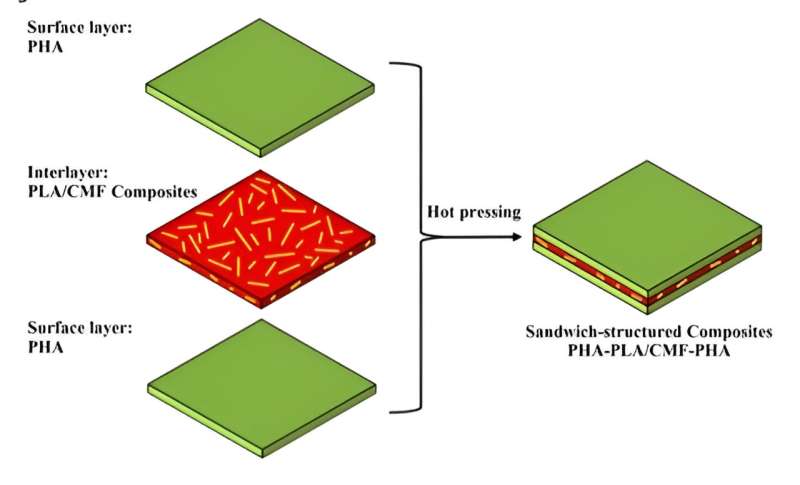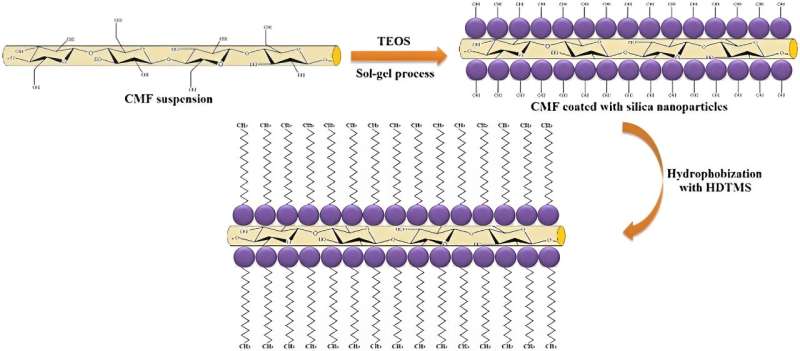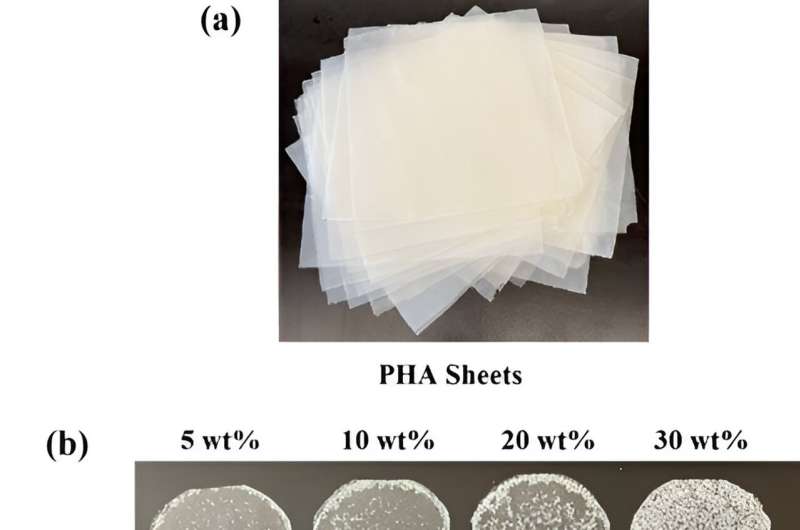December 18, 2023 feature
This article has been reviewed according to Science X's editorial process and policies. Editors have highlighted the following attributes while ensuring the content's credibility:
fact-checked
peer-reviewed publication
trusted source
proofread
A novel sandwich-structured composite from biopolymers for building envelope applications

A new sandwich-structured composite has been developed from the surface layers of polyhydroxyalkanoate (PHA) and the interlayer of polylactic acid and cellulose microfibers. The biodegradable cellulose microfibers can be modified chemically with a sol-gel process to improve the compatibility between natural reinforcement and the polymer matrix.
While the modified cellulose microfibers were chemically developed through different processes to improve the compatibility of natural reinforcement at the polymer matrix, the modified cellulose microfibers showed highly hydrophobic characteristics with homogenous dispersion in the polylactic acid matrix.
Masoud Dadras Chomachayi and a research team at the Laval University, Canada, observed thermogravimetric analyses of the constructs to show improved thermal stability. They improved the mechanical properties of the constructs to increase its tensile modulus and strength. When the scientists added untreated fibers to the constructs, the water vapor permeability of the sandwich composite increased to show the superiority of modified cellulose microfibers when compared to untreated cellulose microfibers to develop building envelopes.
The research is published in the journal Scientific Reports.

The art of building a building envelope
The building envelope is an essential part of a building structure that protects occupants from exterior environmental impacts including sun, rain, snow, wind and pollution. This multilayer passive element is significant for energy efficiency and to maintain the health and comfort of the residents in the building. The process of air leakage, heat transfer and moisture diffusion can have significant effect on the building envelope. For instance, in cold climates, the mass concentration of water vapor on the interior of the building is higher than the exterior, causing the migration of moisture through the building walls.
As a result, diffused moisture can encourage mold growth, reducing the effectiveness of insulation and the deterioration of building envelope materials. At present, there are a variety of barrier membranes in use within the building industry, which include plastic sheeting and rigid foam insulation. Among these materials, polymers are increasingly used to build envelopes. Materials scientists use polyethylene extruded sheets as a prominent vapor barrier membrane; however, its excessive use is harmful to the environment.
The materials composition
Since polyhydroxyalkanoate and polylactic acid are significant biopolymers in the plastic industry, and recent work has seen the use of renewable cellulose-based fillers as polymer composites. In this work, therefore, Chomachayi and colleagues developed a new sandwich-structured barrier membrane from biobased materials, where they added polyhydroxyalkanoate to the surface layers of membranes due to its excellent vapor barrier properties and then added polylactic acid as the interlayer, alongside cellulose microfibers for environmental and economic benefits.
The scientists characterized the prepared sandwich composites relative to their morphology, thermal stability, mechanical properties and vapor barrier performance. They then conducted a durability test to investigate the effect of accelerated aging on the mechanical and barrier properties of the materials.
The researchers examined the surface morphology of cellulose microfibers prior to- and after modification and examined the outcomes with scanning electron microscopy. To impart roughness on the cellulose fibers, the team incorporated spherical silica nanoparticles with a nanoscale diameter, where they derived the nanoparticles from hydrolysis and nucleation of the tetraethylorthosilicate precursor onto the cellulose fibers.
Using Fourier transform infrared analysis, Chomachayi and colleagues determined the chemical structure of the cellulose microfibers prior to and after the sol-gel modification. The scientists characterized the prepared sandwich composites relative to their morphology, thermal stability and mechanical properties.
Mechanism of action
In its mechanism of action, during the sol-gel modification of cellulose microfibers with tetraethylorthosilicate and hexadecyltrimethoxysilane, the team mixed the combined materials in a dispenser and included silicon dioxide nanoparticles on to the material surface. After the reaction, they centrifuged the mixture and obtained hydrophilic cellulose microfibers, which they freeze dried for two days and ground to obtain a cellulose powder. To prepare the sandwich-structured membranes, they created polylactic acid/cellulose microfiber interlayer composites through solvent casting and vacuum-dried the PHA pellets overnight to remove moisture.

The scientists then developed the sandwich structured composites via compression molding and characterized them via a range of methods including scanning electron microscopy, contact angle measurements, thermogravimetric analyses and differential scanning calorimetry.
To assess the impact of sol-gel modification on hydrophobicity of cellulose microfibers, they studied the outcomes using contact angle measurements. For instance, the contact angle values of combined cellulose microfibers and hexadecyltrimethoxysilane were higher than the untreated surfaces. The team conducted a range of experiments to characterize the material surface composition, the chemistry of the constructs and their mechanical properties.
Since the concept of material durability has gained significant attention in Canada, for instance, the team sought to assess the lifespan of polyethylene sheeting for long-term use during vapor barrier membrane applications.
Outlook
In this way, Masoud Dadras Chomachayi and team developed a sandwich-structured membrane using biobased materials, which included polyhydroxyalkanoate, polylactic acid and cellulose microfibers. The barrier membranes regulated the migration of water vapor through the walls to prevent moisture accumulation and long-term stability of the building materials. The research team developed multilayer composites using polyhydroxyalkanoate sheets and fibers reinforced with polylactic acid composites to create modified cellulose microfibers encrusted with spherical silica nanoparticles on the surfaces.
The hydrophilicity and thermal stability of the cellulose microfibers were also enhanced after the sol-gel modification process. The outcomes showed how the Young's modulus of the materials increased by incorporating two key materials into the composites. The successful outcomes symbolize the potential of biopolymers to be useful alternatives to conventional petroleum-based materials during construction applications. Further studies aim to enhance the flexibility of the composites for broader applications.
More information: Dadras Chomachayi et al, Development of a novel sandwich-structured composite from biopolymers and cellulose microfibers for building envelope applications, Scientific Reports (2023). DOI: 10.1038/s41598-023-49273-0
Journal information: Scientific Reports
© 2023 Science X Network





















